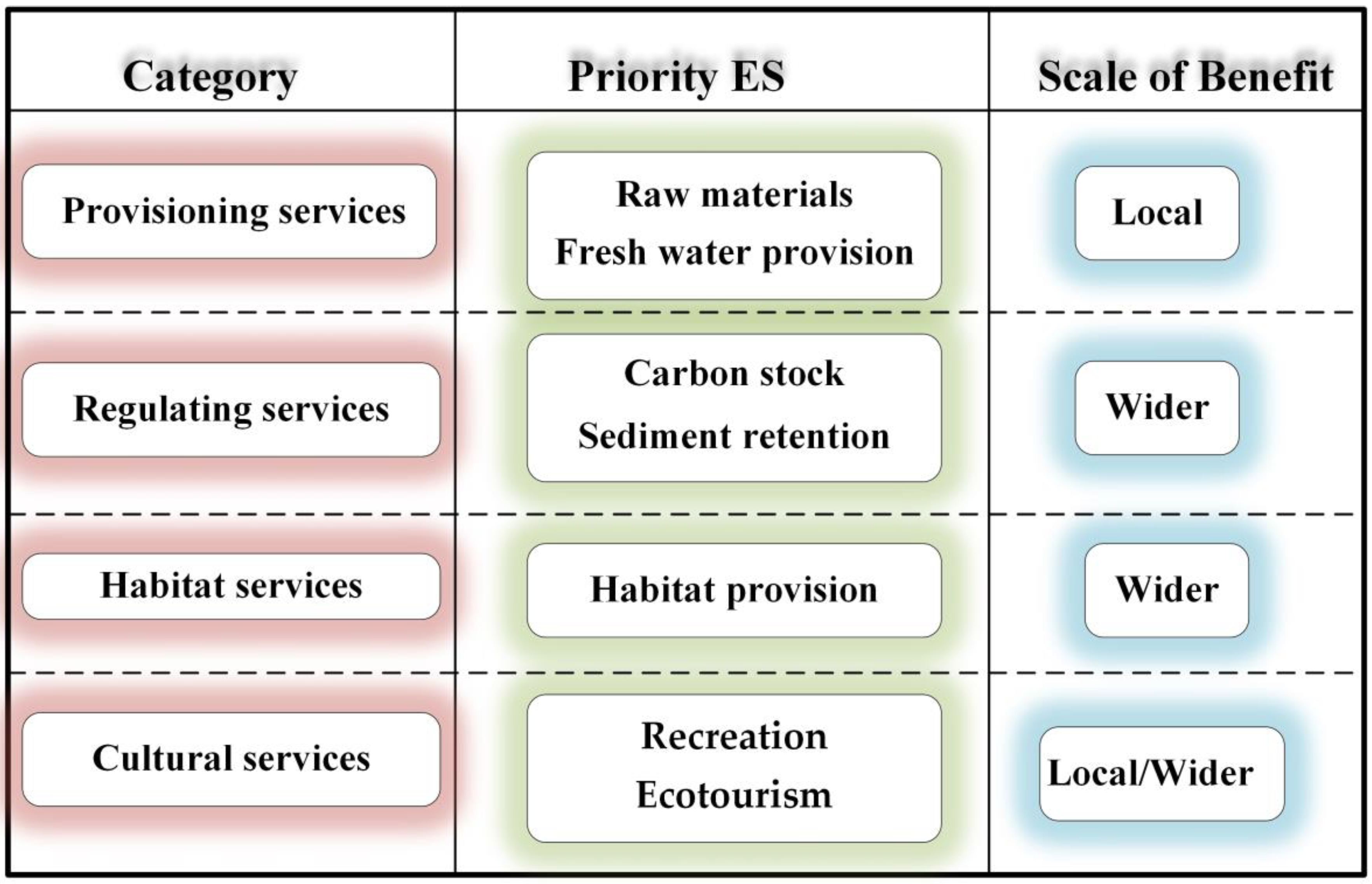Appraisal of Empirical Studies on Land-Use and Land-Cover Changes and Their Impact on Ecosystem Services in Nepal Himalaya
Abstract
1. Introduction
2. Materials and Methods
2.1. Study Area
2.2. Methodological Framework
3. Results
3.1. Changing Trends in LULC at National Level
| Study | Temporal Coverage | Forest Area (km2) | % | Agriculture Area (km2) | % |
|---|---|---|---|---|---|
| LRMP (1986) [24] | 1978–1979 | 56,056 | 38.08 | 40,105 | 27.24 |
| Uddin et al. (2015) [31] | 2010 | 57,540 | 39.09 | 43,910 | 29.83 |
| Reddy et al. (2018) [85] | 1930–2014 | 39,392 | 26.76 | 41,493 | 28.19 |
| Li & Deng (2017) [26] | 1990–2015 | 60,009 | 40.77 | 36,901 | 25.07 |
3.2. Changing Trends in LULC in Ecological Regions
3.3. Changing Trends in LULC in Major River Basins
3.4. Status of Ecosystem Services
4. Discussion
4.1. Land-Use and Land-Cover Changes and Their Impact on Ecosystem Services
4.2. Future Directions and Policy Implications
5. Conclusions
Author Contributions
Funding
Data Availability Statement
Acknowledgments
Conflicts of Interest
References
- NPC. Fifteenth Plan: Mid-Term Evaluation (2019/20–2021/22); National Planning Commission: Kathamandu, Nepal, 2022. [Google Scholar]
- Lambin, E.F.; Geist, H.; Rindfuss, R.R. Introduction: Local processes with global impacts. In Land-Use and Land-Cover Change: Local Processes and Global Impacts; Springer: Berlin/Heidelberg, Germany, 2006; pp. 1–8. [Google Scholar]
- Díaz, S.; Demissew, S.; Carabias, J.; Joly, C.; Lonsdale, M.; Ash, N.; Larigauderie, A.; Adhikari, J.R.; Arico, S.; Báldi, A. The IPBES Conceptual Framework—Connecting nature and people. Curr. Opin. Environ. Sustain. 2015, 14, 1–16. [Google Scholar] [CrossRef]
- MEA. Ecosystems and Human Well-Being: Synthesis; Island Press: Washington, DC, USA, 2005; p. 122. [Google Scholar]
- MEA. Ecosystems and Human Well-Being: Biodiversity Synthesis; World Resources Institute: Washington, DC, USA, 2005; p. 82. [Google Scholar]
- Costanza, R.; De Groot, R.; Sutton, P.; Van der Ploeg, S.; Anderson, S.J.; Kubiszewski, I.; Farber, S.; Turner, R.K. Changes in the global value of ecosystem services. Glob. Environ. Chang. 2014, 26, 152–158. [Google Scholar] [CrossRef]
- Li, Y.; Zhu, X.; Sun, X.; Wang, F. Landscape effects of environmental impact on bay-area wetlands under rapid urban expansion and development policy: A case study of Lianyungang, China. Landsc. Urban Plan. 2010, 94, 218–227. [Google Scholar] [CrossRef]
- De Groot, R.S.; Wilson, M.A.; Boumans, R.M. A typology for the classification, description and valuation of ecosystem functions, goods and services. Ecol. Econ. 2002, 41, 393–408. [Google Scholar] [CrossRef]
- MEA. Ecosystems and Human Well-Being: Health Synthesis; World Resources Institute: Washington, DC, USA, 2005; p. 50. [Google Scholar]
- Song, X.-P.; Hansen, M.C.; Stehman, S.V.; Potapov, P.V.; Tyukavina, A.; Vermote, E.F.; Townshend, J.R. Global land change from 1982 to 2016. Nature 2018, 560, 639–643. [Google Scholar] [CrossRef]
- Lambin, E.F.; Turner, B.L.; Geist, H.J.; Agbola, S.B.; Angelsen, A.; Bruce, J.W.; Coomes, O.T.; Dirzo, R.; Fischer, G.; Folke, C. The causes of land-use and land-cover change: Moving beyond the myths. Glob. Environ. Chang. 2001, 11, 261–269. [Google Scholar] [CrossRef]
- Cheng, S.H.; Ahlroth, S.; Onder, S.; Shyamsundar, P.; Garside, R.; Kristjanson, P.; McKinnon, M.C.; Miller, D.C. What is the evidence for the contribution of forests to poverty alleviation? A systematic map protocol. Environ. Evid. 2017, 6, 10. [Google Scholar] [CrossRef]
- Ramankutty, N.; Foley, J.A. Estimating historical changes in global land cover: Croplands from 1700 to 1992. Glob. Biogeochem. Cycles 1999, 13, 997–1027. [Google Scholar] [CrossRef]
- Turner, B.L.; Lambin, E.F.; Reenberg, A. The emergence of land change science for global environmental change and sustainability. Proc. Natl. Acad. Sci. USA 2007, 104, 20666–20671. [Google Scholar] [CrossRef]
- Turner, B.L.; Meyer, W.B.; Skole, D.L. Global Land-Use/Land-Cover Change: Towards an Integrated Study. Ambio 1994, 23, 91–95. [Google Scholar]
- Costanza, R.; d’Arge, R.; de Groot, R.; Farber, S.; Grasso, M.; Hannon, B.; Limburg, K.; Naeem, S.; O’Neill, R.V.; Paruelo, J.; et al. The value of the world’s ecosystem services and natural capital. Nature 1997, 387, 253–260. [Google Scholar] [CrossRef]
- Burkhard, B.; Kroll, F.; Müller, F.; Windhorst, W. Landscapes’ capacities to provide ecosystem services-a concept for land-cover based assessments. Landsc. Online 2009, 15, 1–22. [Google Scholar] [CrossRef]
- Quintas-Soriano, C.; Castro, A.J.; Castro, H.; Garcia-Llorente, M. Impacts of land use change on ecosystem services and implications for human well-being in Spanish drylands. Land Use Policy 2016, 54, 534–548. [Google Scholar] [CrossRef]
- Nelson, E.; Mendoza, G.; Regetz, J.; Polasky, S.; Tallis, H.; Cameron, D.R.; Chan, K.M.A.; Daily, G.C.; Goldstein, J.; Kareiva, P.M.; et al. Modeling multiple ecosystem services, biodiversity conservation, commodity production, and tradeoffs at landscape scales. Front. Ecol. Environ. 2009, 7, 4–11. [Google Scholar] [CrossRef]
- MEA. Ecosystems and Human Well-Being: Desertification Synthesis; World Resources Institute: Washington, DC, USA, 2005; p. 22. [Google Scholar]
- Lepers, E.; Lambin, E.F.; Janetos, A.C.; DeFries, R.; Achard, F.; Ramankutty, N.; Scholes, R.J. A synthesis of information on rapid land-cover change for the period 1981–2000. Bioscience 2005, 55, 115–124. [Google Scholar] [CrossRef]
- Ellis, E.C.; Ramankutty, N. Putting people in the map: Anthropogenic biomes of the world. Front. Ecol. Environ. 2008, 6, 439–447. [Google Scholar] [CrossRef]
- Miao, L.; Zhu, F.; He, B.; Ferrat, M.; Liu, Q.; Cao, X.; Cui, X. Synthesis of China’s land use in the past 300 years. Glob. Planet. Chang. 2013, 100, 224–233. [Google Scholar] [CrossRef]
- LRMP. Land Utilization Report; Land Resource Mapping Project, Kenting Earth Science Canada and Department of Topography, Government of Nepal: Kathmandu, Nepal, 1986; p. 122.
- Paudel, B.; Zhang, Y.L.; Li, S.C.; Liu, L.S.; Wu, X.; Khanal, N.R. Review of studies on land use and land cover change in Nepal. J. Mt. Sci. 2016, 13, 643–660. [Google Scholar] [CrossRef]
- Ghimire, M. Historical Land Covers Change in the Chure-Tarai Landscape in the Last Six Decades: Drivers and Environmental Consequences. In Land Cover Change and Its Eco-Environmental Responses in Nepal; Li, A., Deng, W., Zhao, W., Eds.; Springer Geography; Springer: New York, NY, USA, 2017; pp. 109–147. [Google Scholar]
- Sharma, S.R.; Upreti, B.R.; Müller-Böker, U. Negotiating Access to Land in Nepal. J. Contemp. Asia 2014, 44, 521–539. [Google Scholar] [CrossRef]
- Gurung, H.; Khanal, N. Landscape processes in the Chure range Central Nepal. Himal. Rev. 1986, 17, 1–39. [Google Scholar]
- WWF-Nepal. Realigining Priorities: Climate Vulnerability Assessment, Terai Arc Landscape; WWF-Nepal: Kathmandu, Nepal, 2016; p. 71. [Google Scholar]
- Paudel, B.; Zhang, Y.; Li, S.; Wu, X. Spatiotemporal reconstruction of agricultural land cover in Nepal from 1970 to 2010. Reg. Environ. Chang. 2017, 17, 2349–2357. [Google Scholar] [CrossRef]
- Uddin, K.; Shrestha, H.L.; Murthy, M.S.R.; Bajracharya, B.; Shrestha, B.; Gilani, H.; Pradhan, S.; Dangol, B. Development of 2010 national land cover database for the Nepal. J. Environ. Manag. 2015, 148, 82–90. [Google Scholar] [CrossRef] [PubMed]
- Paudel, B.; Zhang, Y.; Li, S.; Liu, L. Spatiotemporal changes in agricultural land cover in Nepal over the last 100 years. J. Geogr. Sci. 2018, 28, 1519–1537. [Google Scholar] [CrossRef]
- Kuhle, M. Reconstruction of the Ice Age glaciation in the southern slopes of Mt. Everest, Cho Oyu, Lhotse and Makalu (Himalaya) (Part 1). J. Mt. Sci. 2006, 3, 91–124. [Google Scholar] [CrossRef]
- Shea, J.M.; Immerzeel, W.W.; Wagnon, P.; Vincent, C.; Bajracharya, S. Modelling glacier change in the Everest region, Nepal Himalaya. Cryosphere 2015, 9, 1105–1128. [Google Scholar] [CrossRef]
- Maskey, S.; Uhlenbrook, S.; Ojha, S. An analysis of snow cover changes in the Himalayan region using MODIS snow products and in-situ temperature data. Clim. Chang. 2011, 108, 391–400. [Google Scholar] [CrossRef]
- Shrestha, M.; Wang, L.; Koike, T.; Xue, Y.; Hirabayashi, Y. Modeling the Spatial Distribution of Snow Cover in the Dudhkoshi Region of the Nepal Himalayas. J. Hydrometeorol. 2012, 13, 204–222. [Google Scholar] [CrossRef]
- Bajracharya, S.R.; Maharjan, S.B.; Shrestha, B. The Status of Glaciers in the Hindu Kush-Himalayan Region; International Centre for Integrated Mountain Development (ICIMOD): Kathmandu, Nepal, 2011; p. 140. [Google Scholar]
- Bajracharya, S.R.; Maharjan, S.B.; Shrestha, F.; Bajracharya, O.R.; Baidya, S. Glacier Status in Nepal and Decadal Change from 1980 to 2010 Based on Landsat Data; International Centre for Integrated Mountain Development (ICIMOD): Kathmandu, Nepal, 2014. [Google Scholar]
- Thapa, R.B.; Murayama, Y. Scenario based urban growth allocation in Kathmandu Valley, Nepal. Landsc. Urban Plan. 2012, 105, 140–148. [Google Scholar] [CrossRef]
- Thapa, R.B.; Murayama, Y. Examining Spatiotemporal Urbanization Patterns in Kathmandu Valley, Nepal: Remote Sensing and Spatial Metrics Approaches. Remote Sens. 2009, 1, 534–556. [Google Scholar] [CrossRef]
- Paudel, B.; Gao, J.; Zhang, Y.; Wu, X.; Li, S.; Yan, J. Changes in Cropland Status and Their Driving Factors in the Koshi River Basin of the Central Himalayas, Nepal. Sustainability 2016, 8, 933. [Google Scholar] [CrossRef]
- Gautam, A.P.; Webb, E.L.; Shivakoti, G.P.; Zoebisch, M.A. Land use dynamics and landscape change pattern in a mountain watershed in Nepal. Agric. Ecosyst. Environ. 2003, 99, 83–96. [Google Scholar] [CrossRef]
- Layke, C.; Mapendembe, A.; Brown, C.; Walpole, M.; Winn, J. Indicators from the global and sub-global Millennium Ecosystem Assessments: An analysis and next steps. Ecol. Indic. 2012, 17, 77–87. [Google Scholar] [CrossRef]
- Tolessa, T.; Senbeta, F.; Kidane, M. The impact of land use/land cover change on ecosystem services in the central highlands of Ethiopia. Ecosyst. Serv. 2017, 23, 47–54. [Google Scholar] [CrossRef]
- Rai, R.; Zhang, Y.; Paudel, B.; Acharya, B.K.; Basnet, L. Land Use and Land Cover Dynamics and Assessing the Ecosystem Service Values in the Trans-Boundary Gandaki River Basin, Central Himalayas. Sustainability 2018, 10, 3052. [Google Scholar] [CrossRef]
- Mengist, W.; Soromessa, T.; Legese, G. Ecosystem services research in mountainous regions: A systematic literature review on current knowledge and research gaps. Sci. Total Environ. 2020, 702, 134581. [Google Scholar] [CrossRef]
- Gilani, H.; Qamer, F.M.; Sohail, M.; Uddin, K.; Jain, A.; Ning, W. Review of Ecosystem Monitoring in Nepal and Evolving Earth Observation Technologies. In Land Cover Change and Its Eco-Environmental Responses in Nepal; Li, A., Deng, W., Zhao, W., Eds.; Springer Geography; Springer: New York, NY, USA, 2017; pp. 165–183. [Google Scholar]
- Baniya, B.; Tang, Q.H.; Pokhrel, Y.; Xu, X.M. Vegetation dynamics and ecosystem service values changes at national and provincial scales in Nepal from 2000 to 2017. Environ. Dev. 2019, 32, 100464. [Google Scholar] [CrossRef]
- Zhao, Z.; Wu, X.; Zhang, Y.; Gao, J. Assessment of changes in the value of ecosystem services in the Koshi River Basin, Central High Himalayas based on land cover changes and the CA-Markov Model. J. Resour. Ecol. 2017, 8, 67–76. [Google Scholar] [CrossRef]
- Rimal, B.; Sharma, R.; Kunwar, R.; Keshtkar, H.; Stork, N.E.; Rijal, S.; Rahman, S.A.; Baral, H. Effects of land use and land cover change on ecosystem services in the Koshi River Basin, Eastern Nepal. Ecosyst. Serv. 2019, 38, 100963. [Google Scholar] [CrossRef]
- Shrestha, B.; Ye, Q.; Khadka, N. Assessment of Ecosystem Services Value Based on Land Use and Land Cover Changes in the Transboundary Karnali River Basin, Central Himalayas. Sustainability 2019, 11, 3183. [Google Scholar] [CrossRef]
- Shrestha, K.B.; Maren, I.E.; Arneberg, E.; Sah, J.P.; Vetaas, O.R. Effect of anthropogenic disturbance on plant species diversity in oak forests in Nepal, Central Himalaya. Int. J. Biodivers. Sci. Ecosyst. Serv. Manag. 2013, 9, 21–29. [Google Scholar] [CrossRef]
- Chaudhary, S.; McGregor, A.; Houston, D.; Chettri, N. Environmental justice and ecosystem services: A disaggregated analysis of community access to forest benefits in Nepal. Ecosyst. Serv. 2018, 29, 99–115. [Google Scholar] [CrossRef]
- Acharya, K.P.; Dangi, R.B. Case Studies on Measuring and Assessing Forest Degradation: Forest Degradation in Nepal: Review of Data and Methods; FAO: Italy, Rome, 2009; p. 14. [Google Scholar]
- Acharya, K.P. Twenty-four years of community forestry in Nepal. Int. For. Rev. 2002, 4, 149–156. [Google Scholar] [CrossRef]
- Bijaya, G.C.; Cheng, S.; Xu, Z.; Bhandari, J.; Wang, L.; Liu, X. Community forestry and livelihood in Nepal: A review. J. Anim. Plant Sci. 2016, 26, 1–12. [Google Scholar]
- Dhital, D.; Prajapati, S.; Maharjan, S.R.; Koizumi, H. Soil carbon dioxide emission: Soil respiration measurement in temperate grassland, Nepal. J. Environ. Prot. 2019, 10, 289–314. [Google Scholar] [CrossRef]
- Bhandari, J.; Zhang, Y. Effect of altitude and soil properties on biomass and plant richness in the grasslands of Tibet, China, and Manang District, Nepal. Ecosphere 2019, 10, e02915. [Google Scholar] [CrossRef]
- Baral, S.; Basnyat, B.; Khanal, R.; Gauli, K. A Total Economic Valuation of Wetland Ecosystem Services: An Evidence from Jagadishpur Ramsar Site, Nepal. Sci. World J. 2016, 2016, 2605609. [Google Scholar] [CrossRef]
- Sharma, B.; Rasul, G.; Chettri, N. The economic value of wetland ecosystem services: Evidence from the Koshi Tappu Wildlife Reserve, Nepal. Ecosyst. Serv. 2015, 12, 84–93. [Google Scholar] [CrossRef]
- Yergeau, M.-E. Tourism and local welfare: A multilevel analysis in Nepal’s protected areas. World Dev. 2020, 127, 104744. [Google Scholar] [CrossRef]
- Bhattarai, S.; Pant, B.; Timalsina, N. Conservation without participation: Detrimental effect of escaping people’s participation in protected area management in Nepal. In Protected Areas: Policies, Management and Future Directions; Nova Science Publishers, Inc.: Hauppauge, NY, USA, 2017; pp. 83–104. [Google Scholar]
- Kc, B.; Kandel, P.; Adhikari, S. Economic valuation of ecosystem services in protected areas: A case study from Nepal. Banko Janakari 2013, 23, 42–50. [Google Scholar] [CrossRef]
- Acharya, R.P.; Maraseni, T.N.; Cockfield, G. Local users and other stakeholders’ perceptions of the identification and prioritization of ecosystem services in fragile mountains: A case study of Chure Region of Nepal. Forests 2019, 10, 421. [Google Scholar] [CrossRef]
- Adhikari, S.; Baral, H.; Nitschke, C.R. Identification, Prioritization and Mapping of Ecosystem Services in the Panchase Mountain Ecological Region of Western Nepal. Forests 2018, 9, 554. [Google Scholar] [CrossRef]
- Li, A.; Deng, W. Land Use/Cover Change and Its Eco-environmental Responses in Nepal: An Overview. In Land Cover Change and Its Eco-Environmental Responses in Nepal; Li, A., Deng, W., Zhao, W., Eds.; Springer Geography; Springer: New York, NY, USA, 2017; pp. 1–13. [Google Scholar]
- Li, R.-Q.; Dong, M.; Cui, J.-Y.; Zhang, L.-L.; Cui, Q.-G.; He, W.-M. Quantification of the impact of land-use changes on ecosystem services: A case study in Pingbian County, China. Environ. Monit. Assess. 2007, 128, 503–510. [Google Scholar] [CrossRef] [PubMed]
- Gao, J.; Li, F.; Gao, H.; Zhou, C.; Zhang, X. The impact of land-use change on water-related ecosystem services: A study of the Guishui River Basin, Beijing, China. J. Clean. Prod. 2017, 163, S148–S155. [Google Scholar] [CrossRef]
- Kandel, P.; Tshering, D.; Uddin, K.; Lhamtshok, T.; Aryal, K.; Karki, S.; Sharma, B.; Chettri, N. Understanding social–ecological interdependence using ecosystem services perspective in Bhutan, Eastern Himalayas. Ecosphere 2018, 9, e02121. [Google Scholar] [CrossRef]
- Lu, N.; Fu, B.; Jin, T.; Chang, R. Trade-off analyses of multiple ecosystem services by plantations along a precipitation gradient across Loess Plateau landscapes. Landsc. Ecol. 2014, 29, 1697–1708. [Google Scholar] [CrossRef]
- Han, Z.; Song, W.; Deng, X.; Xu, X. Trade-offs and synergies in ecosystem service within the three-rivers headwater region, China. Water 2017, 9, 588. [Google Scholar] [CrossRef]
- DoS. Political and Adminitrative Boundary of Nepal; Department of Survey, Ministry of Land management, Cooperatives and Poverty Allevation: Kathmandu, Nepal, 2020.
- DNPWC. Protected Areas. 2018. Available online: http://www.dnpwc.gov.np/ (accessed on 7 October 2020).
- CBS. National Population Priliminary Report 2078, Nepali; CBS: Kathmandu, Nepal, 2022. [Google Scholar]
- GoN/MoF. Economic Survey 2018–2019; Government of Nepal, Ministry of Finance: Kathmandu, Nepal, 2018.
- Moher, D.; Liberati, A.; Tetzlaff, J.; Altman, D.G.; The PRISMA Group. Preferred Reporting Items for Systematic Reviews and Meta-Analyses: The PRISMA Statement. PLoS Med. 2009, 6, e1000097. [Google Scholar] [CrossRef]
- Sud, R.; Mishra, A.; Varma, N.; Bhadwal, S. Adaptation policy and practice in densely populated glacier-fed river basins of South Asia: A systematic review. Reg. Environ. Chang. 2015, 15, 825–836. [Google Scholar] [CrossRef]
- Li, A.; Lei, G.; Cao, X.; Zhao, W.; Deng, W.; Koirala, H.L. Land Cover Change and Its Driving Forces in Nepal Since 1990. In Land Cover Change and Its Eco-Environmental Responses in Nepal; Li, A., Deng, W., Zhao, W., Eds.; Springer Geography; Springer: New York, NY, USA, 2017; pp. 41–65. [Google Scholar]
- MoFE. National Level Forests and Land Cover Analysis of Nepal Using Google Earth Images; Ministry of Forest and Environment, Government of Nepal: Kathmandu, Nepal, 2019; p. 46.
- Fox, J.; Saksena, S.; Hurni, K.; Van Den Hoek, J.; Smith, A.C.; Chhetri, R.; Sharma, P. Mapping and understanding changes in tree cover in Nepal: 1992 to 2016. J. Forest Livelihood. 2019, 18, 1–11. [Google Scholar]
- DFRS. State of Nepal’s Forest, Forest Resource Assessment (FRA) Nepal; Department of Forest Research and Survey (DFRS): Kathmandu, Nepal, 2015. [Google Scholar]
- FRTC. National Land Cover Monitoring System of Nepal; Forest Research and Training Centre (FRTC): Kathmandu, Nepal, 2022. [Google Scholar]
- Nield, R. Fuelwood and Fodder-Problems and Policy; Water and Energy Commission Secretariat: Kathmandu, Nepal, 1985; p. 44. [Google Scholar]
- Gautam, A.P.; Shivakoti, G.P.; Webb, E.L. A review of forest policies, institutions, and changes in the resource condition in Nepal. Int. For. Rev. 2004, 6, 136–148. [Google Scholar] [CrossRef]
- Reddy, C.S.; Pasha, S.V.; Satish, K.V.; Saranya, K.R.L.; Jha, C.S.; Murthy, Y. Quantifying nationwide land cover and historical changes in forests of Nepal (1930–2014): Implications on forest fragmentation. Biodivers. Conserv. 2018, 27, 91–107. [Google Scholar] [CrossRef]
- Brandt, J.S.; Allendorf, T.; Radeloff, V.; Brooks, J. Effects of national forest-management regimes on unprotected forests of the Himalaya. Conserv. Biol. 2017, 31, 1271–1282. [Google Scholar] [CrossRef]
- Khanal, N.R. Land Use and Land Cover Dynaics in Teh Himalaya: A Case Study of the Madi Watershed, Western Development Region, Nepal; Tribhuvan University: Kathmandu, Nepal, 2002. [Google Scholar]
- Hrabovszky, J.P.; Miyan, K. Population- growth and Land- use in Nepal “The great turnabout”. Mt. Res. Dev. 1987, 7, 264–270. [Google Scholar] [CrossRef]
- Rimal, B.; Sloan, S.; Keshtkar, H.; Sharma, R.; Rijal, S.; Shrestha, U.B. Patterns of Historical and Future Urban Expansion in Nepal. Remote Sens. 2020, 12, 628. [Google Scholar] [CrossRef]
- Rimal, B.; Zhang, L.F.; Stork, N.; Sloan, S.; Rijal, S. Urban Expansion Occurred at the Expense of Agricultural Lands in the Tarai Region of Nepal from 1989 to 2016. Sustainability 2018, 10, 1341. [Google Scholar] [CrossRef]
- Chaudhary, S.; Wang, Y.; Dixit, A.M.; Khanal, N.R.; Xu, P.; Fu, B.; Yan, K.; Liu, Q.; Lu, Y.; Li, M. A Synopsis of Farmland Abandonment and Its Driving Factors in Nepal. Land 2020, 9, 84. [Google Scholar] [CrossRef]
- Khanal, N.R.; Watanabe, T. Abandonment of agricultural land and its consequences: A case study in the sikles area, gandaki basin, Nepal Himalaya. Mt. Res. Dev. 2006, 26, 32–40. [Google Scholar] [CrossRef]
- Byers, A. An assessment of landscape change in the Khumbu region of Nepal using repeat photography. Mt. Res. Dev. 1987, 7, 77–81. [Google Scholar] [CrossRef]
- Byers, A. Contemporary human impacts on alpine ecosystems in the Sagarmatha (Mt. Everest) National Park, Khumbu, Nepal. Ann. Assoc. Am. Geogr. 2005, 95, 112–140. [Google Scholar] [CrossRef]
- Paudel, B.; Wu, X.; Zhang, Y.; Rai, R.; Liu, L.; Zhang, B.; Khanal, N.R.; Koirala, H.L.; Nepal, P. Farmland abandonment and its determinants in the different ecological villages of the Koshi River Basin, Central Himalayas: Synergy of high-resolution remote sensing and social surveys. Environ. Res. 2020, 188, 109711. [Google Scholar] [CrossRef]
- Muzzini, E.; Aparicio, G. Urban Growth and Spatial Transition in Nepal: An Initial Assessment; The World Bank: Washington, DC, USA, 2013. [Google Scholar]
- Guerra, C.A.; Rosa, I.M.D.; Pereira, H.M. Change versus stability: Are protected areas particularly pressured by global land cover change? Landsc. Ecol. 2019, 34, 2779–2790. [Google Scholar] [CrossRef]
- Haack, B.N.; Rafter, A. Urban growth analysis and modeling in the Kathmandu Valley, Nepal. Habitat Int. 2006, 30, 1056–1065. [Google Scholar] [CrossRef]
- Jaquet, S.; Schwilch, G.; Hartung-Hofmann, F.; Adhikari, A.; Sudmeier-Rieux, K.; Shrestha, G.; Liniger, H.P.; Kohler, T. Does outmigration lead to land degradation? Labour shortage and land management in a western Nepal watershed. Appl. Geogr. 2015, 62, 157–170. [Google Scholar] [CrossRef]
- Shrestha, A.; Joshi, S. Snow Cover and Glacier Change Study in Nepalese Himalaya Using Remote Sensing and Geographic Information System. J. Hydrol. Meteorol. 2009, 6, 26–36. [Google Scholar] [CrossRef]
- Paudel, B.; Zhang, Y.L.; Yan, J.Z.; Rai, R.J.; Li, L.H. Farmers’ perceptions of agricultural land use changes in Nepal and their major drivers. J. Environ. Manag. 2019, 235, 432–441. [Google Scholar] [CrossRef]
- Awasthi, K.D.; Sitaula, B.K.; Singh, B.R.; Bajacharaya, R.M. Land-use change in two nepalese watersheds: Gis and geomorphometric analysis. Land Degrad. Dev. 2002, 13, 495–513. [Google Scholar] [CrossRef]
- KC, B.; Race, D. Outmigration and Land-Use Change: A Case Study from the Middle Hills of Nepal. Land 2020, 9, 2. [Google Scholar] [CrossRef]
- KC, B.K. Internal migration in Nepal. Popul. Monogr. Nepal 2003, 2, 121–168. [Google Scholar]
- Rai, M.K.; Paudel, B.; Zhang, Y.; Khanal, N.R.; Nepal, P.; Koirala, H.L. Vegetable Farming and Farmers’ Livelihood: Insights from Kathmandu Valley, Nepal. Sustainability 2019, 11, 889. [Google Scholar] [CrossRef]
- NPC. Nature Conservation National Strategic Framework for Sustainable Development (2015–2030); Government of Nepal, National Planning Commission Singh Durbar: Kathmandu, Nepal, 2015; p. 99.
- DFRS. Terai Forests of Nepal; Forest Resource Assessment Nepal Project; Department of Forest Research and Survey: Kathmand, Nepal, 2014.
- Garrard, R.; Kohler, T.; Price, M.F.; Byers, A.C.; Sherpa, A.R.; Maharjan, G.R. Land Use and Land Cover Change in Sagarmatha National Park, a World Heritage Site in the Himalayas of Eastern Nepal. Mt. Res. Dev. 2016, 36, 299–310. [Google Scholar] [CrossRef]
- Chidi, C.L. Depopulation and rural land abandonment in the hills of Nepal. SSARSC Int. J. Geosci. Geoinform. 2015, 3, 1–7. [Google Scholar]
- Paudel, K.P.; Tamang, S.; Shrestha, K.K. Transforming land and livelihood: Analysis of agricultural land abandonment in the Mid Hills of Nepal. J. For. Livelihood 2014, 12, 11–19. [Google Scholar]
- Chidi, C.L. Patch Analysis of Cultivated Land Abandonment in the Hills of Western Nepal. In Land Cover Change and Its Eco-Environmental Responses in Nepal; Li, A., Deng, W., Zhao, W., Eds.; Springer Geography; Springer: Singapore, 2017; pp. 149–162. [Google Scholar]
- Khatiwada, S.P.; Zhang, J.; Su, Y.; Paudel, B.; Deng, W. Agricultural Land Use Intensity and Determinants in Different Agroecological Regions in Central Nepal Himalaya. In Land Cover Change and Its Eco-Environmental Responses in Nepal; Li, A., Deng, W., Zhao, W., Eds.; Springer Geography; Springer: Singapore, 2017; pp. 281–305. [Google Scholar]
- Kotru, R.; Rawal, R.S.; Mathur, P.K.; Chettri, N.; Chaudhari, S.A.; Uddin, K.; Murthy, M.S.R.; Singh, S. Effective management of transboundary landscapes- Geospatial applications. In ISPRS Technical Commission Viii Symposium; Dadhwal, V.K., Diwakar, P.G., Seshasai, M.V.R., Raju, P.L.N., Hakeem, A., Eds.; International Archives of the Photogrammetry Remote Sensing and Spatial Information Sciences; Copernicus Gesellschaft Mbh: Gottingen, Germany, 2014; Volume 40-48, pp. 1309–1317. [Google Scholar]
- Wu, X.; Gao, J.; Zhang, Y.; Liu, L.; Zhao, Z.; Paudel, B. Land Cover Status in the Koshi River Basin, Central Himalayas. J. Resour. Ecol. 2017, 8, 10–19. [Google Scholar] [CrossRef]
- Zhang, Y.; Gao, J.; Liu, L.; Wang, Z.; Ding, M.; Yang, X. NDVI-based vegetation changes and their responses to climate change from 1982 to 2011: A case study in the Koshi River Basin in the middle Himalayas. Glob. Planet. Chang. 2013, 108, 139–148. [Google Scholar] [CrossRef]
- Zhang, Y.; Wu, X.; Zheng, D. Vertical differentiation of land cover in the central Himalayas. J. Geogr. Sci. 2020, 30, 969–987. [Google Scholar] [CrossRef]
- Virgo, K.J.; Subba, K.J. Land-use change between 1978 and 1990 in Dhankuta-District, Koshi hills, Eastern Nepal. Mt. Res. Dev. 1994, 14, 159–170. [Google Scholar] [CrossRef]
- Chapagain, P.S.; Rai, M.K.; Paudel, B. Land use land cover change and its pathways in Sidin VDC, Panchthar district, Nepal. Geogr. J. Nepal 2018, 11, 77–94. [Google Scholar] [CrossRef]
- Rai, R.; Zhang, Y.; Paudel, B.; Khanal, N.R. Status of Farmland Abandonment and Its Determinants in the Transboundary Gandaki River Basin. Sustainability 2019, 11, 5267. [Google Scholar] [CrossRef]
- Rimal, B. Urban growth and land use land cover change of Pokhara sub- Metropolitan City, Nepal. J. Theor. Appl. Inf. Technol. 2011, 26, 118–129. [Google Scholar]
- Rimal, B. Urbanization and the decline of agricultural land in Pokhara Sub-metropolitan City, Nepal. J. Agric. Sci. 2013, 5, 54–65. [Google Scholar] [CrossRef]
- Lamsal, P.; Pant, K.P.; Kumar, L.; Atreya, K. Sustainable livelihoods through conservation of wetland resources: A case of economic benefits from Ghodaghodi Lake, western Nepal. Ecol. Soc. 2015, 20. Available online: http://www.jstor.org/stable/26269717 (accessed on 25 March 2023). [CrossRef]
- Uddin, K.; Chaudhary, S.; Chettri, N.; Kotru, R.; Murthy, M.; Chaudhary, R.P.; Ning, W.; Shrestha, S.M.; Gautam, S.K. The changing land cover and fragmenting forest on the Roof of the World: A case study in Nepal’s Kailash Sacred Landscape. Landsc. Urban Plan. 2015, 141, 1–10. [Google Scholar] [CrossRef]
- Fu, B.; Zhang, L.; Xu, Z.; Zhao, Y.; Wei, Y.; Skinner, D. Ecosystem services in changing land use. J. Soils Sediments 2015, 15, 833–843. [Google Scholar] [CrossRef]
- Metzger, M.J.; Rounsevell, M.D.A.; Acosta-Michlik, L.; Leemans, R.; Schröter, D. The vulnerability of ecosystem services to land use change. Agric. Ecosyst. Environ. 2006, 114, 69–85. [Google Scholar] [CrossRef]
- Hasan, S.S.; Zhen, L.; Miah, M.G.; Ahamed, T.; Samie, A. Impact of land use change on ecosystem services: A review. Environ. Dev. 2020, 34, 14. [Google Scholar] [CrossRef]
- Bocchiola, D.; Brunetti, L.; Soncini, A.; Polinelli, F.; Gianinetto, M. Impact of climate change on agricultural productivity and food security in the Himalayas: A case study in Nepal. Agric. Syst. 2019, 171, 113–125. [Google Scholar] [CrossRef]
- Bhatt, D.; Maskey, S.; Babel, M.S.; Uhlenbrook, S.; Prasad, K.C. Climate trends and impacts on crop production in the Koshi River basin of Nepal. Reg. Environ. Chang. 2014, 14, 1291–1301. [Google Scholar] [CrossRef]
- Grima, N.; Singh, S.J. How the end of armed conflicts influence forest cover and subsequently ecosystem services provision? An analysis of four case studies in biodiversity hotspots. Land Use Policy 2019, 81, 267–275. [Google Scholar] [CrossRef]
- Thapa, K. Prospect of Financing Protected Areas through Payment for Ecosystem Services in Nepal. Int. Res. J. Environ. Sci. 2015, 4, 84–91. [Google Scholar]
- Bhandari, P.; Mohan, K.C.; Shrestha, S.; Aryal, A.; Shrestha, U.B. Assessments of ecosystem service indicators and stakeholder’s willingness to pay for selected ecosystem services in the Chure region of Nepal. Appl. Geogr. 2016, 69, 25–34. [Google Scholar] [CrossRef]
- Chaudhary, S.; Chettri, N.; Uddin, K.; Khatri, T.B.; Dhakal, M.; Bajracharya, B.; Ning, W. Implications of land cover change on ecosystems services and people’s dependency: A case study from the Koshi Tappu Wildlife Reserve, Nepal. Ecol. Complex. 2016, 28, 200–211. [Google Scholar] [CrossRef]
- Pakhtigian, E.L.; Jeuland, M. Valuing the environmental costs of local development: Evidence from households in Western Nepal. Ecol. Econ. 2019, 158, 158–167. [Google Scholar] [CrossRef]
- Dhakal, B.; Kattel, R.R. Effects of global changes on ecosystems services of multiple natural resources in mountain agricultural landscapes. Sci. Total Environ. 2019, 676, 665–682. [Google Scholar] [CrossRef]
- Peh, K.S.-H.; Thapa, I.; Basnyat, M.; Balmford, A.; Bhattarai, G.P.; Bradbury, R.B.; Brown, C.; Butchart, S.H.; Dhakal, M.; Gurung, H. Synergies between biodiversity conservation and ecosystem service provision: Lessons on integrated ecosystem service valuation from a Himalayan protected area, Nepal. Ecosyst. Serv. 2016, 22, 359–369. [Google Scholar] [CrossRef]
- Gurung, H. Nepal: Consequences of migration and policy implications. Contrib. Nepal. Stud. 1988, 15, 67–94. [Google Scholar]
- Subedi, B.P. International migration in Nepal: Towards an analytical framework. Contrib. Nepal. Stud. 1991, 18, 83–102. [Google Scholar]
- Sharma, P. Urbanization and development. Popul. Monogr. Nepal 2003, 1, 375–412. [Google Scholar]
- Whelpton, J. A History of Nepal; Cambridge University Press: Cambridge, MA, USA, 2005. [Google Scholar]
- Nepal, P.; Khanal, N.R.; Zhang, Y.L.; Paudel, B.; Liu, L. Land use Policies in Nepal: An Overview. Land Degrad. Dev. 2020, 31, 2203–2212. [Google Scholar] [CrossRef]
- Chaudhary, S.; McGregor, A.; Houston, D.; Chettri, N. Spiritual enrichment or ecological protection? A multi-scale analysis of cultural ecosystem services at the Mai Pokhari, a Ramsar site of Nepal. Ecosyst. Serv. 2019, 39, 100972. [Google Scholar] [CrossRef]
- Paudyal, K.; Baral, H.; Bhandari, S.P.; Bhandari, A.; Keenan, R.J. Spatial assessment of the impact of land use and land cover change on supply of ecosystem services in Phewa watershed, Nepal. Ecosyst. Serv. 2019, 36, 100895. [Google Scholar] [CrossRef]
- Paudyal, K.; Baral, H.; Bhandari, S.P.; Keenan, R.J. Design considerations in supporting payments for ecosystem services from community-managed forests in Nepal. Ecosyst. Serv. 2018, 30, 61–72. [Google Scholar] [CrossRef]
- Haack, B.N.; Khatiwada, G. Rice and Bricks: Environmental Issues and Mapping of the Unusual Crop Rotation Pattern in the Kathmandu Valley, Nepal. Environ. Manag. 2007, 39, 774–782. [Google Scholar] [CrossRef] [PubMed]
- Liu, J.; Li, S.; Ouyang, Z.; Tam, C.; Chen, X. Ecological and socioeconomic effects of China’s policies for ecosystem services. Proc. Natl. Acad. Sci. USA 2008, 105, 9477–9482. [Google Scholar] [CrossRef] [PubMed]
- Delang, C.O.; Yuan, Z. China’s Grain for Green Program; Springer: Cham, Switzerland, 2016. [Google Scholar]
- Ahmad, A.; Ahmad, S.; Nabi, G.; Liu, Q.-J.; Islam, N.; Luan, X. Trends in deforestation as a response to management regimes and policy intervention in the Hindu Kush Himalaya of Pakistan. Front. Environ. Sci. 2022, 10, 125. [Google Scholar] [CrossRef]
- Heinen, J.T.; Shrestha, S.K. Evolving policies for conservation: An Historical Profile of the Protected Area System of Nepal. J. Environ. Plan. Manag. 2006, 49, 41–58. [Google Scholar] [CrossRef]
- Bhatta, L.D.; van Oort, B.E.H.; Rucevska, I.; Baral, H. Payment for ecosystem services: Possible instrument for managing ecosystem services in Nepal. Int. J. Biodivers. Sci. Ecosyst. Serv. Manag. 2014, 10, 289–299. [Google Scholar] [CrossRef]
- Chaudhary, S.; McGregor, A. A critical analysis of global ecosystem services (Paristhitiki sewa) discourse in Nepal. Land Use Policy 2018, 75, 364–374. [Google Scholar] [CrossRef]
- Bhatta, L.D.; Khadgi, A.; Rai, R.K.; Tamang, B.; Timalsina, K.; Wahid, S. Designing community-based payment scheme for ecosystem services: A case from Koshi Hills, Nepal. Environ. Dev. Sustain. 2018, 20, 1831–1848. [Google Scholar] [CrossRef]

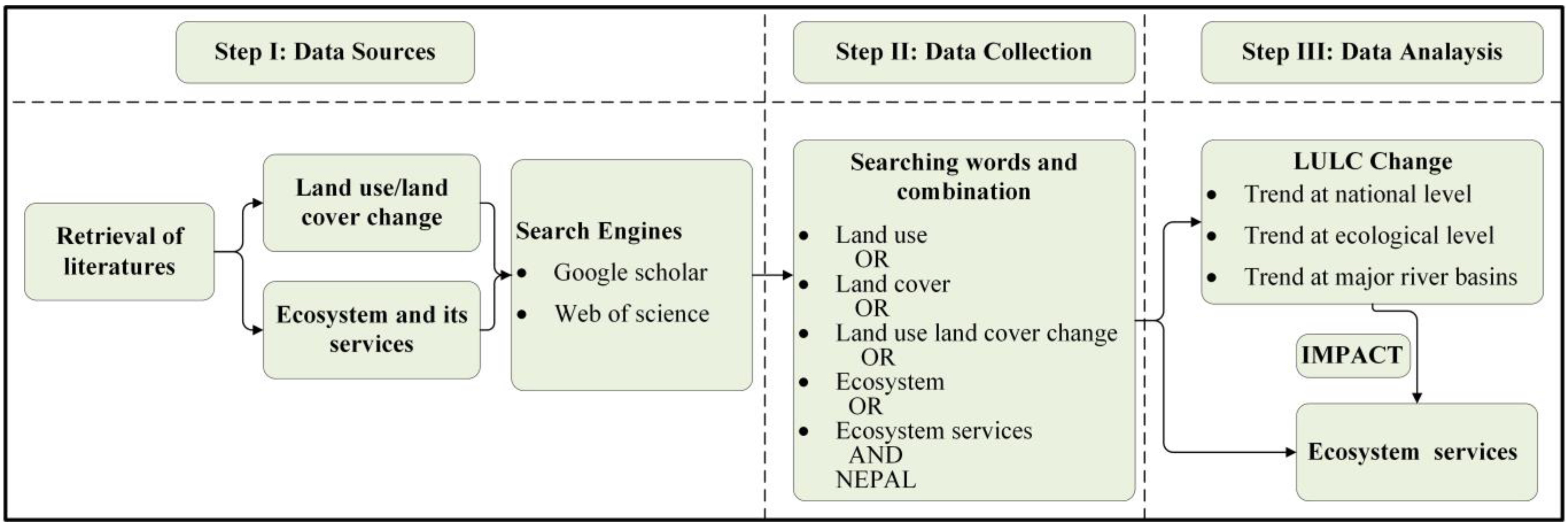
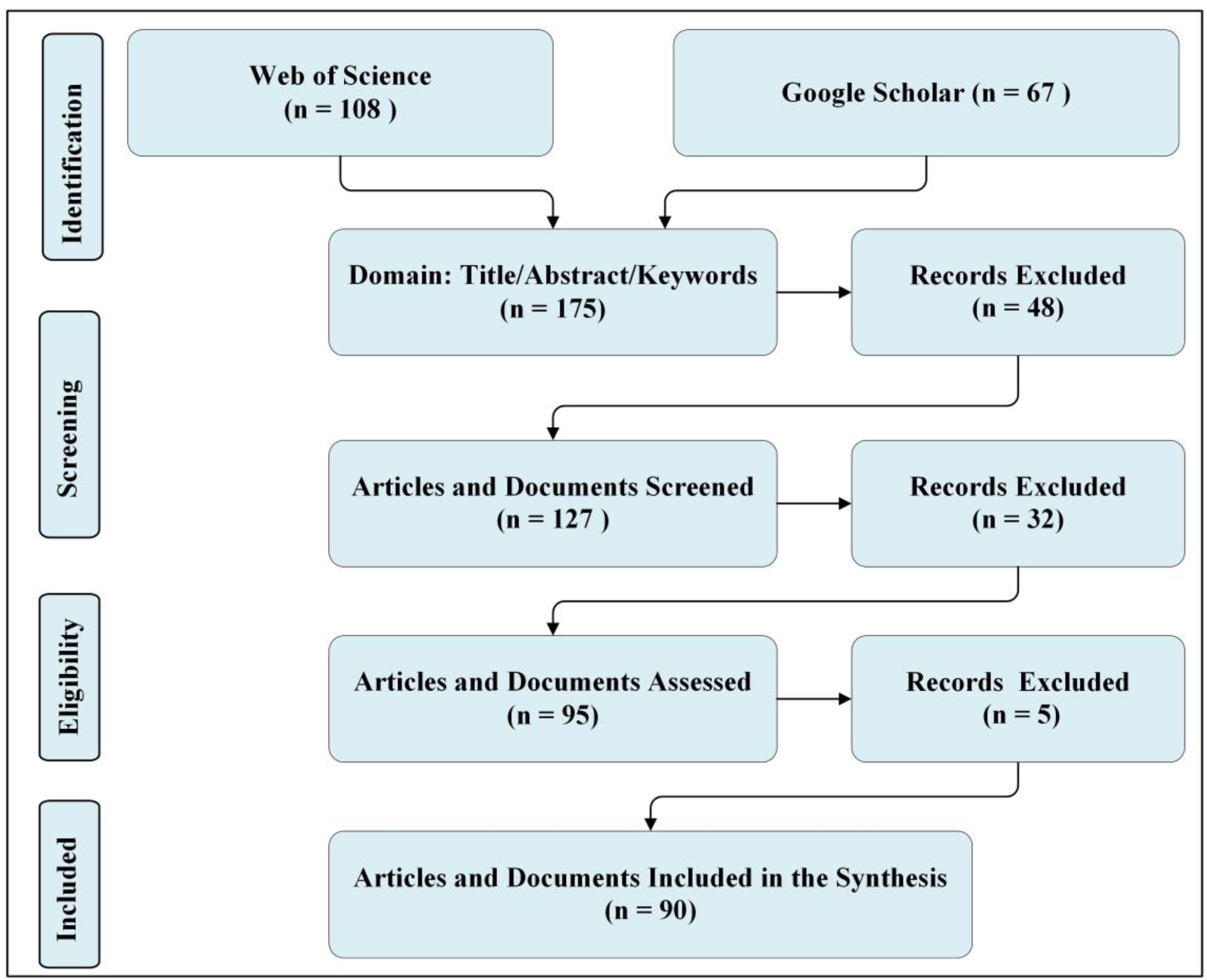
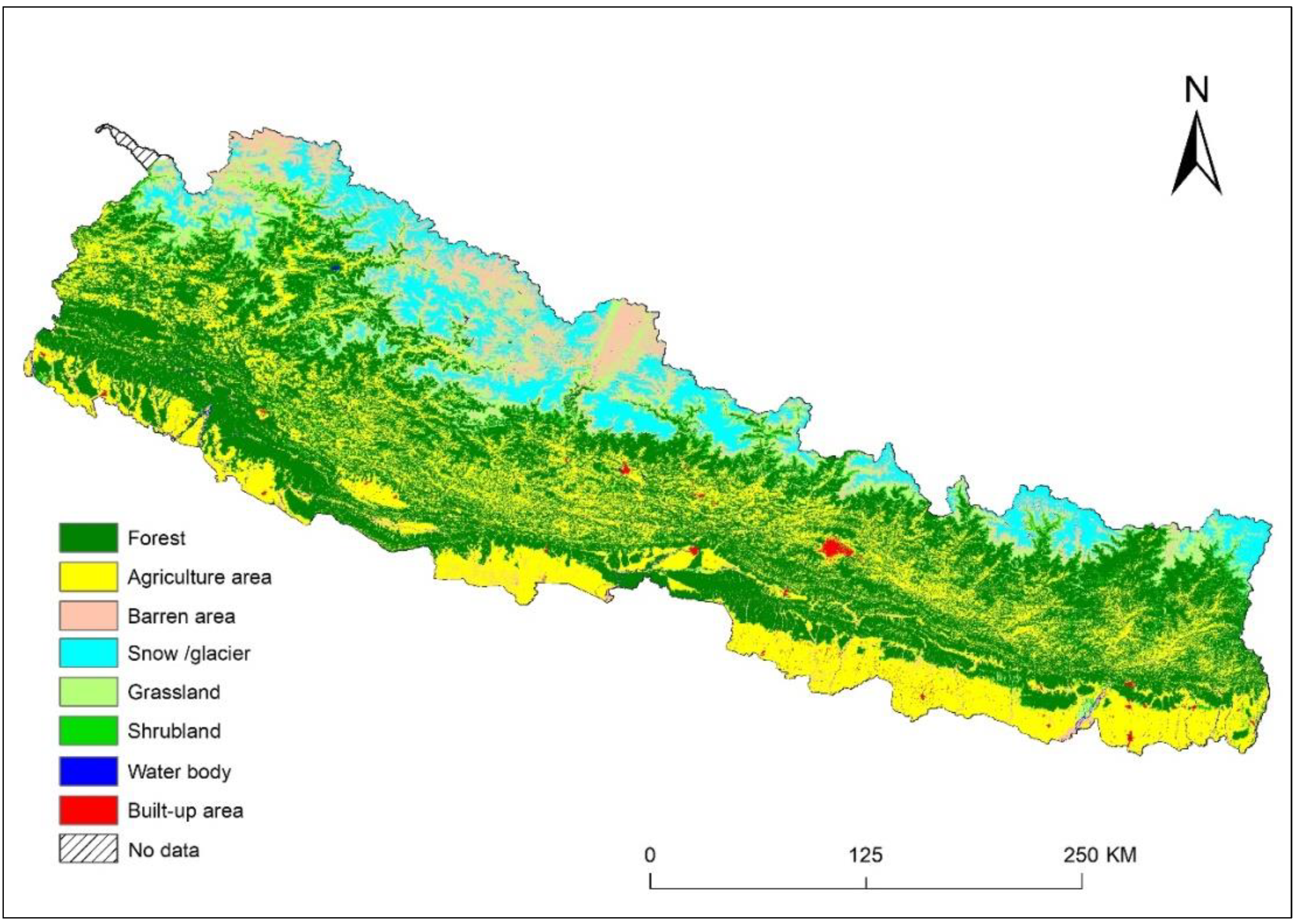
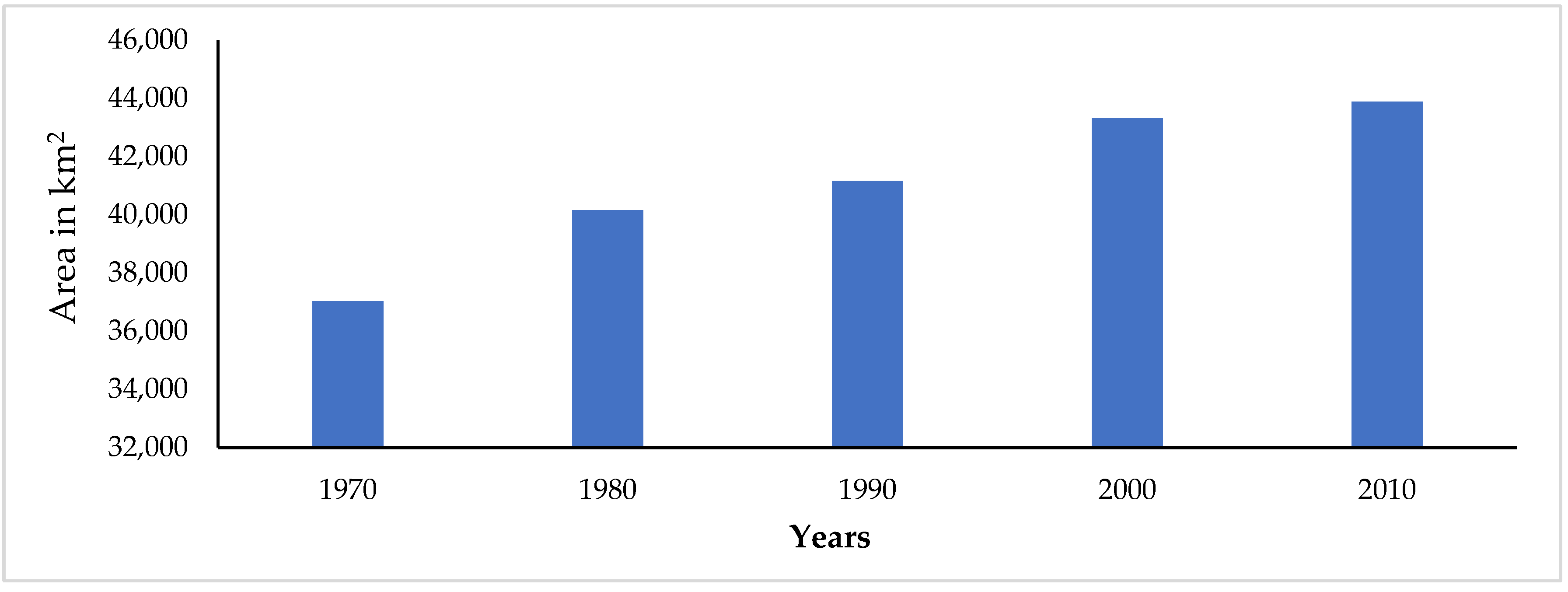
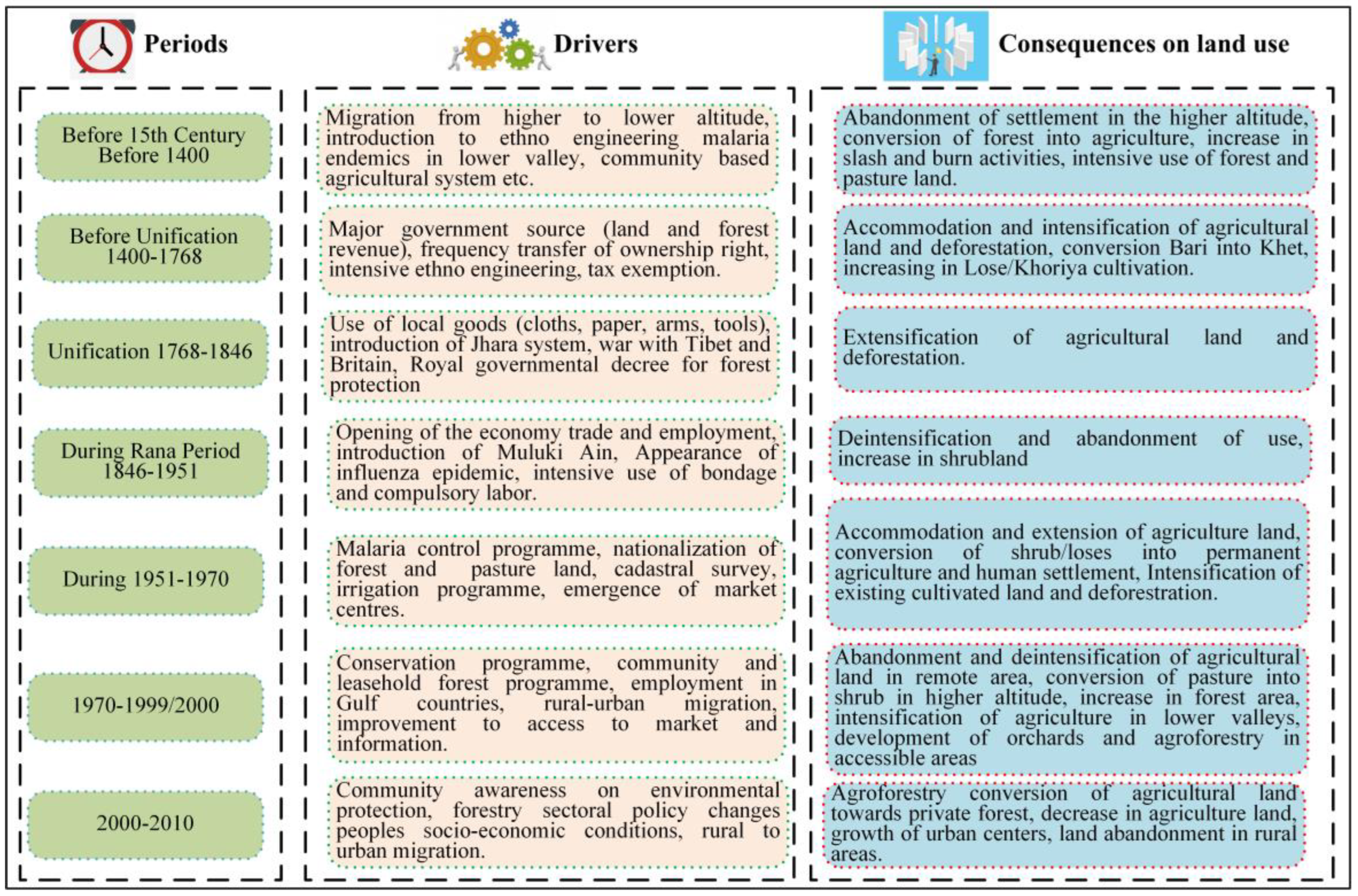
| Citeria Included | Criteria Excluded |
|---|---|
| Research published between 1986 and 2020 | Research published before 1986 and after 2020 |
| Empirical studies on land use, ecosystems, and their associated services | Model validation and methodological refinement |
| Peer-reviewed articles | Proceedings, editorial, and un-reviewed documents |
| Research relevant to Nepal | Research not relevant to Nepal |
Disclaimer/Publisher’s Note: The statements, opinions and data contained in all publications are solely those of the individual author(s) and contributor(s) and not of MDPI and/or the editor(s). MDPI and/or the editor(s) disclaim responsibility for any injury to people or property resulting from any ideas, methods, instructions or products referred to in the content. |
© 2023 by the authors. Licensee MDPI, Basel, Switzerland. This article is an open access article distributed under the terms and conditions of the Creative Commons Attribution (CC BY) license (https://creativecommons.org/licenses/by/4.0/).
Share and Cite
Rai, M.K.; Paudel, B.; Zhang, Y.; Nepal, P.; Khanal, N.R.; Liu, L.; Rai, R. Appraisal of Empirical Studies on Land-Use and Land-Cover Changes and Their Impact on Ecosystem Services in Nepal Himalaya. Sustainability 2023, 15, 7134. https://doi.org/10.3390/su15097134
Rai MK, Paudel B, Zhang Y, Nepal P, Khanal NR, Liu L, Rai R. Appraisal of Empirical Studies on Land-Use and Land-Cover Changes and Their Impact on Ecosystem Services in Nepal Himalaya. Sustainability. 2023; 15(9):7134. https://doi.org/10.3390/su15097134
Chicago/Turabian StyleRai, Mohan Kumar, Basanta Paudel, Yili Zhang, Pashupati Nepal, Narendra Raj Khanal, Linshan Liu, and Raju Rai. 2023. "Appraisal of Empirical Studies on Land-Use and Land-Cover Changes and Their Impact on Ecosystem Services in Nepal Himalaya" Sustainability 15, no. 9: 7134. https://doi.org/10.3390/su15097134
APA StyleRai, M. K., Paudel, B., Zhang, Y., Nepal, P., Khanal, N. R., Liu, L., & Rai, R. (2023). Appraisal of Empirical Studies on Land-Use and Land-Cover Changes and Their Impact on Ecosystem Services in Nepal Himalaya. Sustainability, 15(9), 7134. https://doi.org/10.3390/su15097134








